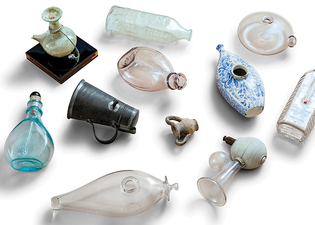
Anthony Decarlo/Yale School of Medicine
The baby bottles shown here date all the way back to the Roman Republic and all the way up to the twentieth century. School of Medicine professor emeritus Howard Fink has said he collected them because of his profession: “Any pediatrician would naturally be interested.”
View full image
In an 1886 column for Babyhood magazine, an anonymous writer from Northampton, Massachusetts, wrote, “I have never yet seen the baby who could not be well and strong and happy with . . . a sweet and clean bottle. . . . Let no one imagine that I am trying to give the bottle the place of honor which a healthy nursing-mother holds by right, but only a word of comfort to the many mothers who sadly and trembling feel that the death warrant is signed when the bottle is prescribed.” A decade later, another Babyhood columnist suggested that “A good breast is a blessing, a poor one may be a delusion, a mockery, and a snare.”
Although they were written more than one hundred years ago, these words may seem familiar to any twenty-first-century parent who has encountered conflicting advice about how to best feed an infant. Catchphrases like “All women can breastfeed” and “Breast is best” are met with passionate rebukes: “Fed is best.”
While these debates are divisive, at their core is one fundamental tenet: infant feeding is both a critical concern for parents and a critical part of childhood health. The antique baby bottle collection shown here—donated to Yale New Haven Hospital by Howard Fink, a Yale School of Medicine professor emeritus—traces more than 2,000 years of these concerns, showing us changing priorities in child-rearing, medical advice, and parenting technologies.
Take, for example, the Roman Infant Feeding Vessel—the tiny brown vessel with two handles. It dates back to 200–100 BCE and was found in an Italian child’s tomb. We’ll never know about the child who used the vessel, or about the family who buried their child. However, we know that the Roman physician Galen advised sick mothers against nursing, believing that it harmed the child, and suggested that children should be weaned when they cut their first teeth. (Galen thought bread was an appropriate first food; unlike many of his contemporaries, he advised against starting with wine.)
Consider also the cylindrical Pennsylvania Tin Feeder, dating from 1774, which has a spout projecting from its side. The gray metal container was not without risk. (“This morning, the child received almost a miraculous deliverance from choking, by a pin, which he suck’d out of the silver nipple of his bottle,” wrote Cotton Mather in 1700.) But for at least one child, it was a source of comfort and nutrition. Perhaps the child’s mother, returning to work on her farm postpartum, had been advised by a midwife that the bottle was less risky than a potentially negligent wet nurse who might accidentally crush a child in her sleep—a concern of some midwives.
We may wonder why the collection contains many more bottles from the nineteenth and twentieth centuries than from the preceding two millennia. While there are numerous complex reasons, we can look at least partly to a nineteenth-century explosion of new medical information that connected improper feeding techniques with infant mortality, resulting in new feeding technologies. We can put ourselves in the places of mothers who read articles like those in Babyhood to educate themselves about how to best care for their children. As we’re imagining these mothers, we might grimace in sympathy as we think about the ways this was sometimes an impossible task: the nineteenth-century bottles, made before the development of germ theory or sanitary techniques like pasteurization, had narrow, difficult-to-clean openings. We can imagine the children who got sick despite the best efforts of their parents. In the twentieth century, the bottles become wider and more durable, to allow health measures such as sterilization before use.
In many cases, the experiences of the individual children who used these bottles, of the parents who cared for them, and of the professionals who advised them have been lost to history. But by spending some time with these unique objects and by thinking about medical culture in the years when they were created, we can find fragments of their stories, and perhaps find moments of symmetry with our own.
 loading
loading